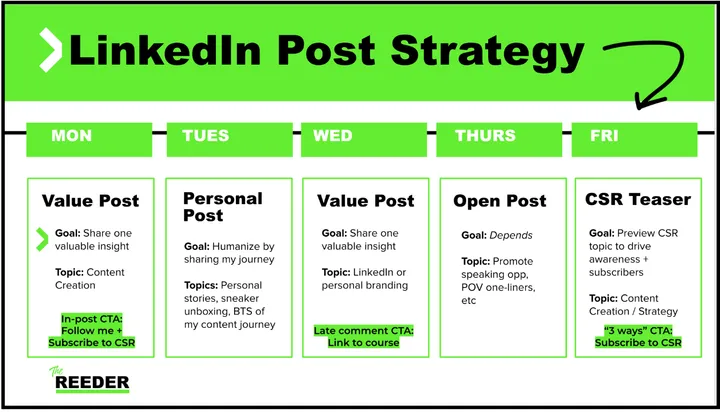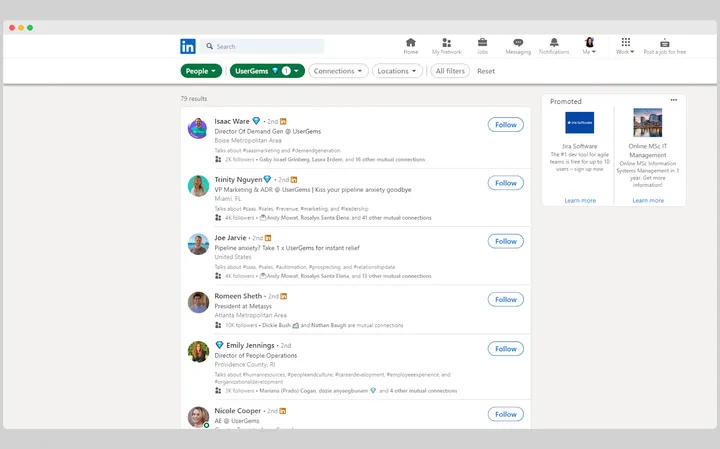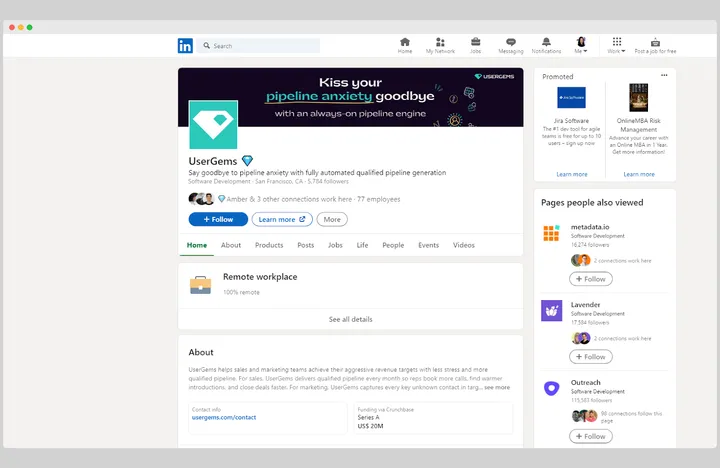500,000 views.
That’s the total number of views the Dreamdata team generated 91 days after launching their social selling campaign on LinkedIn.
Employee advocacy, also known as social selling, happens when individuals make use of social media platforms to become ambassadors to their company.
This is great because oftentimes when people think of a company, they imagine a lifeless entity sitting on a piece of land.
A LinkedIn employee advocacy program flips this script by making your employees the face of the brand, and their posts a reliable library of information about the company’s culture and value proposition.
But to create a successful LinkedIn employee advocacy program, you’ll have to factor in a lot of things. Like the rules of the platform, the company’s goals, and the willingness of the employees to participate.
Sounds like hard work? Only if you don’t know how to get started.
By the end of this piece, you’ll be able to implement a LinkedIn employee advocacy program that generates views and revenue for your company.
But before that…
Why implement an employee advocacy strategy on LinkedIn?
An employee advocacy program leads to a win-win situation for both the company and its employees.
Here’s why:
Boosts Employees’ Personal Brand
Of course, an employee advocacy program is created for the company’s good. But do you know who first reaps the benefit? The employees.
The ones who act as the ambassadors for the company and are responsible for implementing the strategy.
So in between regular posts, interactions, and private discussions, they enjoy increased profile views from any of the 800m+ LinkedIn users. Also, if they succeed in niching down as a creator on a particular subject matter, their reputation, and credibility in that field skyrockets. This also gives them more confidence in their role. All of which adds up to building your employee’s personal brand.
But it doesn’t stop there.
Their association with the company with a growing reputation also improves their image. It’s the way past and present Google employees gladly mention their affiliation with it because of the reputation it has grown over the years.
Increases Brand Awareness
Employee advocacy should be tied to business goals for your company. With so many eyes on employees’ content centered around the value proposition of your company’s products, insider look, and updates, it’s free and organic PR for your company.
So, more people have awareness of what your company does, the stories, the wins, and the growth, and how different roles collaborate. This is branding in ways that a press release, paid ad, and influencer marketing can’t compare.
An example of this is Tracey Wallace at Klaviyo who used her Linkedin page to promote Klaviyo’s SMS Consumer report.
PlayPlay's Linkedin video maker is the perfect solution to effortlessly create professional videos for your business and increase brand awareness, regardless of your experience or expertise.
Access to Networking and Partnership Opportunities
Now, this concerns both the employees and the company itself.
Starting with the employees who by building their brand, get to have conversations with colleagues in similar roles or industries. They are also exposed to opportunities like podcast features, speaking opportunities (which they can also use to market the company), new clients, personal business ideas, and more.
LinkedIn confirms that social sellers on their platforms create 45% more opportunities for themselves than those who don’t.
For instance, a single post can become a conversation starter between two or more people right there on the platform or in private chats.
Another understated aspect of networking is also how it builds employees’ internal relationships with each other. Steve Watt describes it this way
On the part of the company, content and business partnership is a big deal for companies trying to penetrate new spaces, and capture large audience shares. These partnerships will happen because the stakeholders already have an understanding of the company’s vision, goals, and product and can tap into the intersection of all three for their good.
Attracts Qualified Talent
Ever wondered what it’s like to work for a company based on what you heard about them from past and present employees? One of the ways this happens is through an employee advocacy program. With 52 million job applicants active on the platform, you can imagine the impact of messaging about a company’s culture or operations being amplified by a dedicated army.
What makes these talents more qualified is that they would have already done a self-evaluation to see if there's a culture fit. Or they’ll be coming with a level of preparedness to impress you at the point of application or interview.
Four Steps to creating an employee advocacy program on LinkedIn
Linkedin employee advocacy is not as simple as making random posts. It thrives if there’s an alignment with the business goals, plus a level of dedication from employees.
So use this step-by-step process for creating an employee advocacy program on LinkedIn.
Involve the Company Executives
The first thing you need to do to ensure the success of your Linkedin advocacy program is to get buy-in from the company heads. And this is not about their approval, it's getting them to start the campaign as the company’s biggest ambassadors. Doing this inspires action from the employees, who will later be the driving force of the advocacy program.
To make it work:
Batch produce content
Come up with a schedule for brainstorming content that can be spread in different formats over weeks and months.
Presently, Chris Walker who’s the CEO of Refine Labs, and the face of their employee advocacy program creates an average of two videos weekly. That’s aside from engaging with professionals in his space. And he has been at this for almost three years.
Hire Ghostwriters
Ghostwriting is now a big deal in the content writing space, as it's a nice way for leaders to share their ideas, or attach their name to a brilliant piece written by someone else. Before, it was simply think pieces in Forbes, entrepreneur.com, and other business websites.
Now, it has trickled down to the social media space for everyone to participate. You can hire a ghostwriter for your management team to work with in coming up with ideas, and bringing them to life.
There’s also the option of appointing someone in-house to take up this role of creating content in the executive’s name.
After which the Executive publishes under their profile, and engages with their audience at their own pace.
Build a Dedicated Team
The fear most employees have with advocacy programs is that participation is compulsory and it affects their remuneration.
Remove this pressure by allowing people voluntarily participate. This eventually motivates others to participate when they see their colleagues reaping its benefits.
In setting up this team, the biggest participants may be those from your marketing and sales team, but a mixture of people from different departments spices things up. For instance, you can have those in marketing emphasizing your product’s value prop, while those in the technical departments can show the product development journey.
To make it work:
Have someone head the advocacy program
It could be an external hand, a new hire, or someone in the HR or comms team. This person will be in charge of planning the advocacy strategy, following up with participants, and reporting on results.
Start with those that actively post on LinkedIn
These are the easiest people to recruit and the team can tap into their enthusiasm for the platform and the program in general. Talk to them and understand their motivation, willingness to factor in the company in their content creation plan, and even suggestions they have on using the platform.
Create a Special Channel
Take it a step further by having special channels(could be on slack) for this small team you’ve built. There, you state the ground rules which include: posting frequency, engagement hacks, and content distribution plan.
Members can also use this platform to motivate each other, suggest better ideas for the program, and document the growth of the program. This way, later partakers will have something solid to fall back on.

Use PlayPlay video templates
You can make use of videos for walking participants through the program requirements and other necessary details for getting started at the early stage. PlayPlay also has an idea machine that employees can use in generating ideas and incorporating video marketing into their personal advocacy plans.
Give them creative freedom
A good employee advocacy program runs on content. But it gets better when you give people the freedom to create this content as they wish.
At most, you can share ideas, themes, and the necessary metrics. Other than this, allow them to speak in their voice and based on their understanding of a subject matter. This way, any interaction – whether positive or negative – that arises from their post is one they can handle.
To make it work:
Explore different content formats
Creativity comes in different forms and your advocacy team should be free to explore them as they like. Whether it’s written, audio, or video content, as long as they are following the laid down rules of advocacy, they are good to go.
Mix up the content type
Writing prompts, and diverse content type is other ways to allow your employees to get creative.
Here are some recommended content types to get the best results from your team:
- Value proposition content: this highlights the benefits of the products which the company creates. For instance, someone can make a post sharing how much time a project management tool helps teams save regularly. Company case studies, testimonials from customers, or a preview of a blog post works well here.
- Company updates: here, employees look out for company updates, and share an interesting part of it based on what their audience needs. It goes a long way in announcing to a broader audience what the company is up to.
- Culture and behind-the-scenes moments: what is it like working in your company? What’s their policy on employee well-being? Any fun activities? Let the world get a peek into this through LinkedIn posts from your employees. This type of content can also come around a celebratory period like when someone celebrates X number of years at a company, and shares relationships they built in the company. The tone of this type of content should be light-hearted and incite goodwill.
- Personal stories: at the core of every brand strategy is storytelling. Employees can appear more relatable by sharing life updates, career journeys, past work experiences, family time, hobbies, and industry hot takes.
- Thought Leadership: best left for C-suite and senior roles as it performs better when you have enough experience backing it up. They can share advice on career growth, expand on product journeys, how to hire, and memorable events since becoming a founder or taking up a leadership role.
Devin Reed who was one of the biggest employee advocate for Gong adopts a similar strategy for his Linkedin content. Here’s what it looks like:
Empower them with resources
No matter how enthusiastic the employees are about this program, an extra nudge to help with content creation goes a long way. Therefore make it easy for participants by giving them the right tools to get started.
To make it work:
Have periodic workshops
This is to set ground rules and train them on what to expect and how to handle whatever comes up.
Provide training materials
This includes courses, webinars, templates, and even a content calendar of suggested topics.
How to encourage your employees to participate?
When launching an employee advocacy program, understand that not everyone will participate. This doesn’t make them bad employees, less ambitious, or less career-oriented. However, while you extend grace to participants, get more people as possible to participate by:
Reducing the barrier to entry
Yes, we’ve talked about how an employee advocacy program thrives on content, but what if people participate without the obligation of creating content?
Instead, let them work as advocates by supporting the active content creators with likes and comments, using emojis or icons to further show their alliance with the company. Or having unique headlines that summarize the value propositions of the company.
UserGems is great at this as a key identifier of their employees on Linkedin is the diamond emoji, plus a headline that talks about pipeline anxiety.
Here’s what that looks like:
Notice how most of these profiles have a similar headline or emoji.
The company’s page is also in alignment with this strategy.
Incentivizing Participants
Come up with tangible gifts or offers for participants as a way of letting them know you appreciate the time from the productive hours they use to promote the company. It could be in form of gift cards, coupons, shoutouts, and more.
Making it competitive is another way to add a layer of incentives for the advocates. For instance, you can state that anyone who pulls in the highest number of views on a post in a week gets access to a course they want or a dinner at a restaurant of their choice.
Now people have higher reasons to go hard and can get more creative to boost views.

Company Culture is important
If you find that few people are willing to join the advocacy program, you may want to work on your company culture. If employees don’t consider the company a great place to work, they won’t be willing to make any extra effort to promote it, even with incentives attached.
Sharing results
Be transparent about the program. Let people see in real-time, how impactful their efforts are. It re-emphasizes that it’s teamwork and motivates them to keep going.
How to measure the results of an employee advocacy campaign on LinkedIn?
The best way to measure the results of an employee advocacy campaign is to revisit the goals you set while building it and analyze each success metric.
These metrics include:
- Company page views
- Audience engagement (likes and comments)
- Website visits
- Sign-ups, trials, and referrals
- Increased brand sentiment
Some of these can be tracked through your company’s LinkedIn page, but you can take it a step further by using tools like Oktopost, Smarp, and Dynamic Signal for social media management, internal communications, and content generation for your advocacy team.
Your team may not end up with 500,000 views like Dream Data, and that’s fine. Decide what winning means for your company and stick to it.
Create an Engaging LinkedIn Employee Advocacy Program Using Videos
If you take away one thing from this post, it should be that your willingness to explore with your team determines the success of your employee advocacy program.
When you’re ready to take your advocacy program to the next level, get inspiration from these content marketing influencers killing it using videos.
Melissa Francois
Head of Global Content & Comms
With over 10 years of experience in the wild world of SaaS, Melissa cares about building great brand stories and driving community engagement through engaging content. Off the clock, she enjoys long walks and a pint in a cozy country pub.







